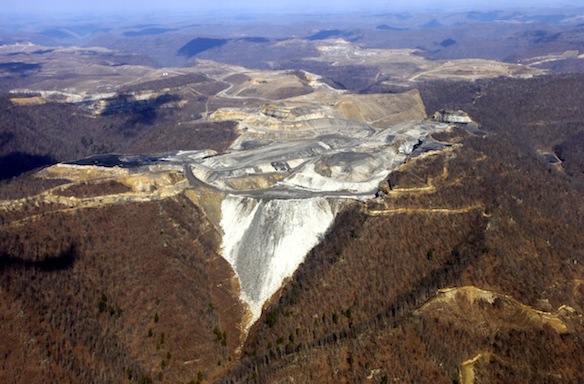EPA Proposes Veto of the Largest Mountaintop Mine in West Virginia
Coal industry defenders were quick to blast the EPA’s intervention as a threat to jobs.
Jul 31, 202074.1K Shares1.4M Views
A mountaintop coal mine in West Virginia (Rick Eglinton/Toronto Star/ZUMA Press)
In a show that the Obama administration is serious about putting the teeth back into the Clean Water Act, the Environmental Protection Agency today jump-started a process that could kill one of the largest mountaintop coal mining operations ever allowed in Appalachia. The decision — which is already being attacked by powerfulcoal-country Democrats— marks the first time in the EPA’s history that it has invoked its CWA authority to question the legitimacy of a permitted project.
[Environment1]Mountaintop removal refers to the process of blowing the tops off of mountainsto uncover the seams of coal inside. The soil, rock, trees and other debris are then pushed into adjacent valleys, often burying tiny streams representing the headwaters of larger rivers below.
West Virginia’s Spruce No. 1 Mine, approved under the Bush administration, would devour 2,278 acres of wooded mountains in southern Logan County. The operation would fill six Appalachian valleys with 110 million cubic yards of debris, burying more than seven miles of headwater streams over the next 15 years.
Most of the project has been stalled in recent years by a series of lawsuits filed by community activists. But the EPA under the Obama administration has also taken a great interest in the project. Today they took that interest a step further, issuing a “proposed determination” that could lead to restrictions on the extent of the mining — or a veto of the permit altogether.
Among the EPA’s concerns surrounding Spruce No. 1, officials said the mine “will cause** **adverse impacts to drinking water, native aquatic and water-dependent communities in the Spruce Fork watershed.” Runoff from the project is likely to include selenium and other pollutants, which will “adversely affect the naturally occurring aquatic communities.” All told, the mine will result in “the cumulative loss of water quality, aquatic systems, and forest resources.”
That the EPA has the authority to stop such a project is not in question. The Clean Water Act empowersthe agency to restrict or prevent dumping when the debris “will have an unacceptable adverse effect on municipal water supplies, shellfish beds and fishery areas (including spawning and breeding areas), wildlife, or recreational areas.” But laws are only as good as their enforcement, and EPA officials under the Bush administration spent eight years looking the other way as permit after permit was approved for mountaintop removal mines.
The reason is clear. The coal industry is a juggernaut of influence on Capitol Hill. And its defenders were quick on Friday to blast the EPA’s intervention as a threat to jobs in one of the most destitute nooks of the country. The National Mining Association, for example, argued that the EPA’s decision “adds further uncertainty for jobs and economic security throughout Appalachia.”
Sen. Jay Rockefeller (D-W.V.) weighed inas well, calling it “wrong and unfair for the EPA to change the rules for a permit that is already active.”
Rep. Nick Rahall (D-W.V.), the chairman of the House Natural Resources Committee who represents Logan County, agreed, callingthe EPA’s move “an unprecedented, unjustified and undeserved decision.”
“The owners of the Spruce Mine worked in good faith over the course of many years with State and Federal permitting agencies, including the EPA, and the permit was issued after the conclusion of a full environmental impact statement,” Rahall said. “To come back now and pull the rug out from under this mining operation is unconscionable.”
He’s right about one thing; the move is unprecedented. Under the Clean Water Act, the Army Corps of Engineers makes most permit decisions, but the EPA can step in to delay pending permits — or veto existing ones — if the agency has reason to believe the disposal sites will harm water supplies or ecosystems. EPA has used its CWA veto authority just 12 times since 1972, the agency claims, and never before has it done so for a project that was already permitted.
EPA officials defended their decision Friday, arguing that the agency is simply fulfilling its obligations under the CWA. “We must prevent the significant and irreversible damage that comes from mining pollution — and the damage from this project would be irreversible,” Shawn Garvin , EPA regional administrator for the Mid-Atlantic, said in a statement. “EPA has a duty under the law to protect water quality and safeguard the people who rely on these waters for drinking, fishing and swimming.”
Environmentalists were quick to throw their support behind the move as well. Ed Hopkins, director of environmental quality at the Sierra Club, said the news is indication that evidence-based decision-making is returning to the EPA after eight years in the wilderness under the Bush administration. “The best available science tells us that proposed mines like the massive Spruce Mine would pollute waterways, destroy mountains and devastate communities,” Hopkins said in a statement.
The EPA’s proposed determination will be published in the Federal Register on April 2, with a 60-day public comment period to follow.
“We hope that the agency follows through on this recommendation,” Hopkins said.

Rhyley Carney
Reviewer
Latest Articles
Popular Articles
